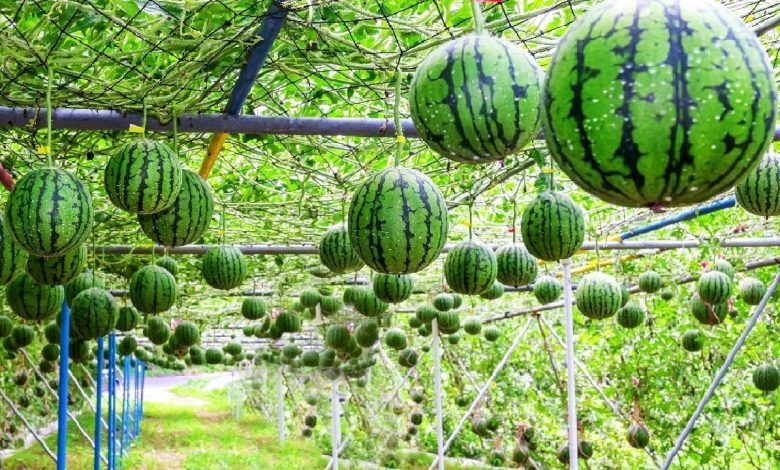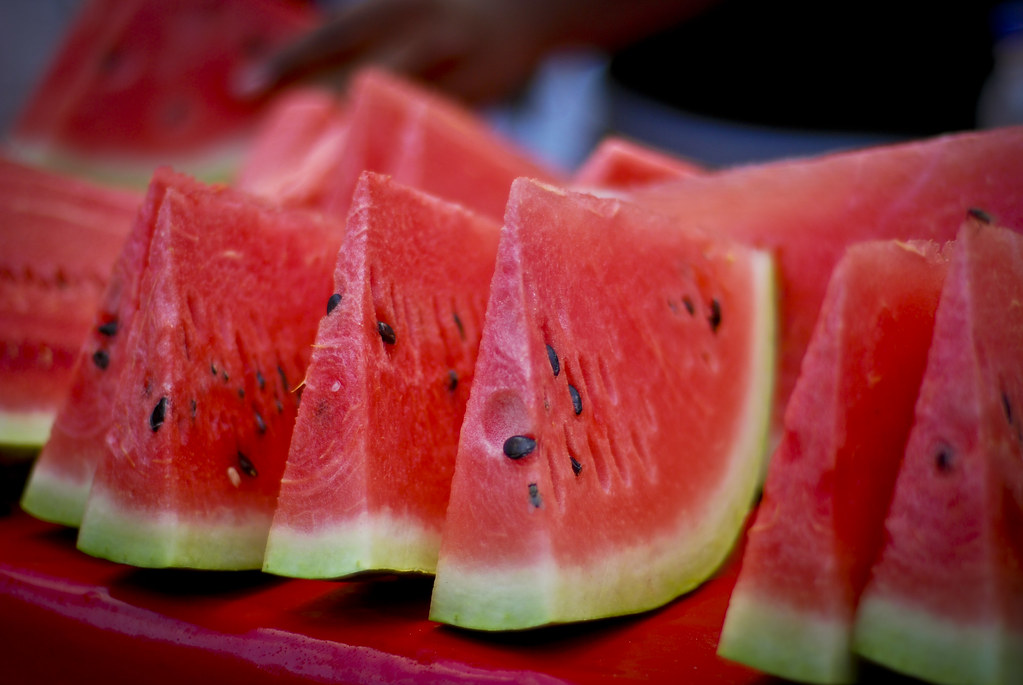Watermelon Farming in India with complete Guidelines

Watermelon has gained interest worldwide. Farmers grow watermelon in all tropical and subtropical regions of the globe. Therefore, watermelon fruit is a warm-season crop. Farmers cultivate it mainly for its flesh and juice, which is delicious and rich in water. This combination makes this watermelon demand-able worldwide during the summer season. Hence, commercial watermelon cultivation mostly takes place in the summer season. If proper farming methods and farm management strategies are followed, watermelon farming is profitable. Female and male flowers bloom on an individual plant.
The fruit’s size varies from 2 to 15 kg. It depends on the variety of the fruit. However, in the case of seedless varieties, pollinators are required. The market demand for watermelon is further increasing by using fruit shapes. Farmers can successfully cultivate in containers, pots, indoor greenhouses and poly houses.

Process of Watermelon Farming in India
You need to know the essential sections to help in profitable commercial farming when you start a plant to plant. We can provide information related to more reliable tractors in watermelon farming. You can use the Eicher tractor and any other, which aids in the whole process of cultivation. Here we are describing information about starting and operating successful watermelon farming.
1. Climate Requirement
Farmers cultivate the watermelon mainly in hot-arid and sub-tropical regions. Watermelon crops can not tolerate the cold climate, and mild frost can damage the cultivation. If you take the risk of cultivating crops in winter, you should need special care to protect yourself from any frost. A dry climate and sunshine are too essential to produce high-quality watermelon. You should choose the ideal temperature for cultivating the watermelon to approximately 18 to 35 degrees Celsius. For watermelon cultivation, it is ideal to have warm days and cool nights.
You should choose the optimum temperature for the germination of seeds above 21 °C. During the vegetative growth period, high humidity can make the crop susceptible to several fungal diseases. Temperatures higher than 36 °C and below 10 °C will slow down fruit growth and maturity.
2. Soil Requirement
For watermelon cultivation, sandy loam and black soil are suitable for good organic matter. But you can choose alluvial soil because this soil also is best for watermelon cultivation. The pH range optimum for watermelon cultivation ranges from 6.0 to 7.5.
3. Land Preparation
The best season for watermelon sowing is December, as this will help the fruits to get ready for the summer season. You should also prepare the cultivable land for good tillage by one or two crosswise ploughings. The field where the crops are cultivating then you should level it, and be sure to remove any weeds from previous crops.
Before sowing, you should soak the seeds in lukewarm water for a period of 12 to 15 hours. After draining the water, the seeds are placing in a wet sack. This treatment will help to increase the germination percentage. Generally, 3 to 4 kg of seed is required for planting in 1 hectare of land.
4. Sowing Method
Kund Method:
The grooves are opened at a distance of two to three metres. Sowing should take place on both sides of the furrows. You can allow the vines to stand on the ground. At a 60 – 90 cm distance, 3 to 4 seeds are sown along the trunk.
Pit Method:
You should dig pits of size 60 cm x 60 cm x 60 cm at a distance of two to 3.5 m x 0.6 to 1.2 m. It is then filled with farm manure (FYM) and soil in equal proportions. You should sow four seeds/pits and you should keep at the end 2 to 3 healthy vines.
Hill Method:
You should dig pits of size 30 cm x 30 cm x 30 cm at a distance of 1 m to 1.5 m while planting on the river bed. You fill the pits with equal amounts of soil and farmyard manure (FYM). Then, you should plant the 2 seeds on each hill, and the soil is pill up in the form of a hill.
5. Seed Treatment
Before sowing, you should treat the seeds to prevent attacks from disease and pests. You should also give a boost to germination. Treat the seeds with Carbendazim 2 grams/kg, Pseudomonas fluorescens 10 grams, or Trichoderma viridian 4 grams of watermelon seeds.
6. Irrigation for Watermelon Cultivation
You should irrigate the field before dibbling the seeds. Farmers should do the subsequent irrigation once a week. You should do the irrigation at regular intervals of time.
There have been incidents of fruit breakage of irrigated watermelons after a prolonged drought. Therefore, drip irrigation is the best option for water scarcity areas. Install a drip system with main and sub-main pipes and inline lateral tubes at 1.5 m intervals. Place the drippers in lateral tubes at 60 to 50 cm intervals with 4 LPH and 3.5 LPH capacities, respectively.
Need the Equipment in the Watermelon Cultivation
When you want to get information about farming, you should also know the tools that will help in increasing the yield. Rotavator, cultivator, tiller and tractor are essential in every farming. However, of all the equipment, the tractor is the most important. That’s why we recommend the New Holland Tractor for watermelon cultivation in India.
For more information regarding watermelon farming in India, stay tuned with us.


